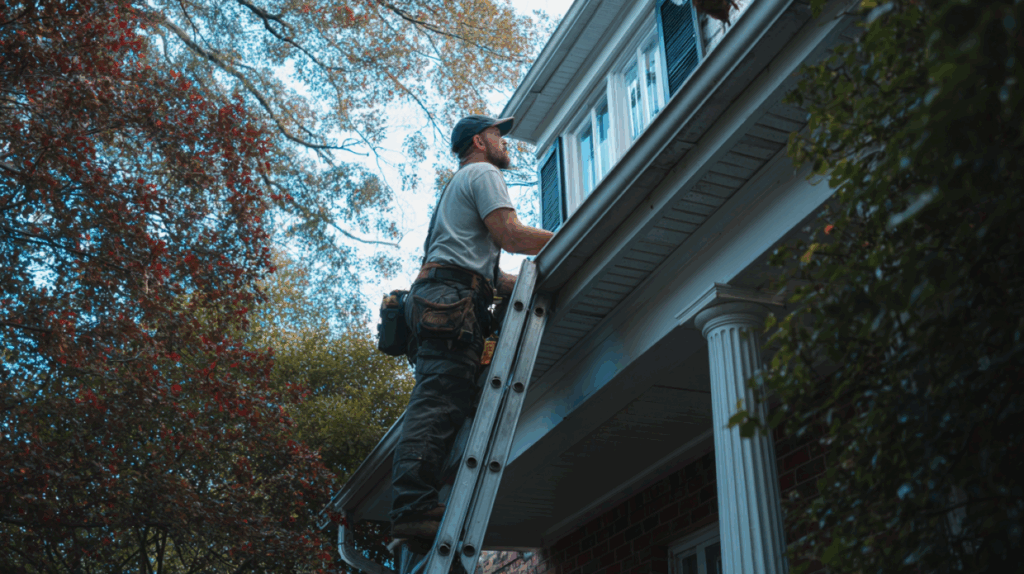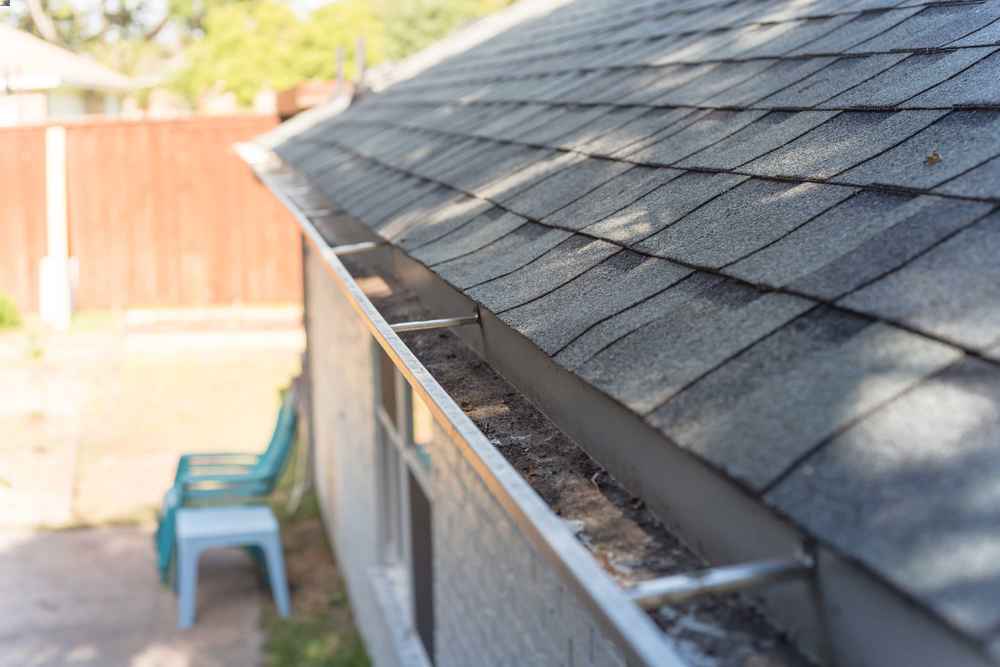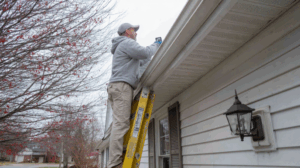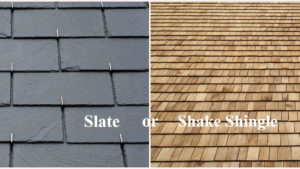If you live around Indianapolis, you know how fast fall slides into winter here. One minute you’re pulling leaves out of your gutters, the next you’re watching snow and ice clog the same runs. That’s exactly why these gutter cleaning tips matter—especially in Indiana weather, where winter’s first freeze hits before you’ve had a chance to blink. At Cornett Roofing Systems, we’ve seen houses saved by a simple gutter sweep—and others that needed major work because the system failed.
Here’s what you’ll walk away with:
- Why cleaning your gutters now protects your home in Indiana’s early‑winter conditions
- How to prep your system safely and thoroughly for the snow ahead
- A step‑by‑step guide you can follow now—right up to the first snowfall
- A closer look at gutter materials, risk factors and how we support homeowners around Indianapolis
- Answers to the frequent questions we hear from local homeowners
Cornett Roofing Systems is here to help get your gutters winter‑ready—schedule a free inspection today.
Why Now is the Time: The Role of Gutters in Indiana Winters
Let’s be clear: gutter cleaning tips aren’t just about clearing leaves—they’re part of protecting your whole exterior. In the Indianapolis region, late‑fall brings leaves, early cold snaps set in, and snow follows swiftly. If your gutters are blocked or misdirected, melting snow has no outlet—and that’s how damage starts.
Your gutters do more than carry water—they protect your roof edge, siding, and even your foundation. When they fail, the consequences ripple through the entire structure. That’s why reading our Year‑Round Roof Maintenance Guide comes in handy—because gutters and roof systems are inextricably linked.

Pre‑Cleaning Prep: What You Should Do Before the Ladder Goes Up
Before you climb and scoop, take a few smart steps so your effort counts.
- Plan your budget & map your timing. Aim for cleaning just before the first heavy snowfall, and set aside funds for tools, cleanup—or professional help if your home is two‑ storey.
- Gather tools & materials. Ladder (proper height and stabilization), gloves, tarp or bucket, garden hose for flushing, and maybe a ladder stabilizer for safety.
- Check access & safety. Steep roofs or overhanging trees make DIY risky. If you’re unsure, it’s a smart call to hire pros.
- Ensure proper drainage. In Indiana’s freeze‑thaw environment, your downspouts must lead water at least 3–5 feet from the foundation to avoid soil shifting or basement issues.
- Set a post‑cleanup inspection date. Mark your calendar to revisit right after a heavy snow or rapid thaw to make sure things are still flowing.
How to Clean Your Gutters & Protect Your Home (Step‑by‑Step)
Clear Debris & Test the Flow
Remove large debris
Start by scooping out leaves, seed pods, and other buildup from your gutters. In Indiana, late autumn is heavy with tree drop—if you wait until snow comes, you’re fighting uphill.
Flush with a hose
Once gutters are clear, use a garden hose to test the flow. If water stalls or spills over the edges, you’ve got a problem to fix—either downspouts clogged or connections loose.
Inspect for Damage & Correct Weak Points
Check for sagging or misaligned sections
Gutters that pull away, sag, or show rust are weak spots waiting for snow and ice to exploit. Reset brackets, realign runs and make sure everything is secured.
Verify downspouts and proper drainage
Water should exit far from the house—not landing 12 inches away. In our freeze‑thaw climate, poor drainage means foundation and basement risks later in the season.
Shield Against Snow & Ice Hazards
Consider guards or heat cables
When cold hits, a blocked gutter becomes an ice dam. Gutter guards reduce debris entry, and heat cables maintain flow when temps drop.
Inspect after the first snow or thaw
Once snow falls, head back for a quick check. If gutters remain clogged or flow is inhibited, it’s time for corrective work—not waiting until spring.

Deep Dive: Gutter Materials, Winter Risks & Long‑Term Strategy
Common Materials & Their Strengths
- Aluminum gutters: A cost‑friendly, common choice—lightweight, but may bend under heavy snow.
- Steel gutters: Stronger for larger loads, but risk rust without strong coating.
- Copper or custom metal: Premium look and performance—but higher cost and specialist install.
Indiana‑Specific Risk Factors
- Freeze‑thaw cycles cause expansion in small cracks, which worsens system failure.
- Heavy early leaf fall plus first snow means debris accumulation before you expect it.
- Tree coverage near Indianapolis causes faster gutter loading and faster system failure if ignored.
- Ice build‑up at roof edges from blocked gutters taxes your roof system too.
How Cornett Roofing Systems Helps
We inspect, document, correct materials, advise on guards or heat systems, and ensure your gutters support the rest of your exterior—including your roof system. This is especially critical in Indiana winters.
Pros and Cons Snapshot
| Gutter Material | Pros | Cons |
| Aluminum | Affordable, easy to replace | Less resilient under heavy snow/ice load |
| Steel | Excellent load capacity | May rust without proper finish or care |
| Copper/Custom Metal | Long‑life, premium look | Higher upfront cost, specialist install |
Gutter Maintenance Questions Indiana Homeowners Are Asking
Before the first snowfall hits, many Indiana homeowners have similar concerns about how to protect their gutters—and their homes. Here are five of the most common questions we hear and what you need to know.
What happens if I don’t clean my gutters before winter?
If you don’t clean your gutters before winter, you risk ice dams, roof edge leaks, and even foundation damage. Clogged gutters trap water that freezes, overflows, and backs up under shingles or down your walls.
Are heated gutter cables worth it for Indiana winters?
Yes, heated gutter cables can be worth it for Indiana winters—especially on homes prone to ice dams. These systems help melt snow and keep water flowing, reducing the risk of freeze-related blockages.
Can I clean gutters myself, or should I always hire a pro?
You can clean gutters yourself if you have safe ladder access and the right tools, but many homeowners prefer to hire a pro—especially if the roof is steep, the gutters are high, or trees make debris cleanup more frequent.
How do I know if my downspouts are working properly?
You can tell your downspouts are working properly by running water through your gutter system and checking for fast, clear flow at the base. If water backs up, leaks out, or doesn’t exit far from your foundation, there’s likely a problem.
Is gutter maintenance covered under my roof warranty?
Gutter maintenance is not usually covered by a roof warranty, but it is often required to keep that warranty valid. If a claim arises and you haven’t maintained your gutters, it could void coverage on your roof system.
Conclusion: Make Your Gutters Winter‑Ready, and Stay Ahead
Getting your gutters cleaned and inspected before snow hits isn’t just an item on your to‑do list—it’s one of the smartest moves you can make for your home’s exterior this season. Using these solid gutter cleaning tips, you’ll protect your roof, foundation and siding from freeze‑thaw damage, ice accumulation and drainage failures.
For over 30 years, Cornett Roofing Systems has helped homeowners in the region protect their properties with quality workmanship, reliable service and deep regional experience. If you’re thinking about your gutters (and the rest of your exterior) before winter sets in—schedule your free inspection today.





